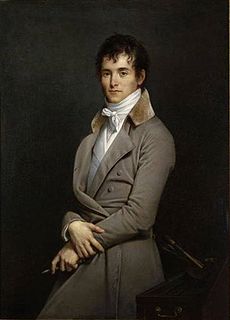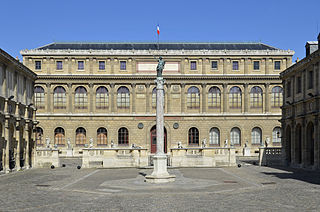
Thomas Couture was a French history painter and teacher. He taught such later luminaries of the art world as Édouard Manet, Henri Fantin-Latour, John La Farge, Pierre Puvis de Chavannes, Karel Javůrek, and J-N Sylvestre.

Pierre-Narcisse, baron Guérin was a French painter born in Paris.

Léon Cogniet was a French history and portrait painter. He is probably best remembered as a teacher, with more than one hundred notable students.

François-Auguste Biard, born François Thérèse Biard was a French painter, known for his adventurous travels and the works depicting his experiences.

Jean Alaux, called "le Romain", was a French history painter and Director of the French Academy in Rome from 1846–52.

Louis Candide Boulanger was a French Romantic painter, pastellist, lithographer and a poet, known for his religious and allegorical subjects, portraits, genre scenes.

École des Beaux-Arts refers to a number of influential art schools in France. The term is associated with the Beaux-Arts style in architecture and city planning that thrived in France and other countries during the late nineteenth century and the first quarter of the twentieth century.

Fleury François Richard, sometimes called Fleury-Richard, was a painter of the École de Lyon. A student of Jacques-Louis David, Fleury-Richard and his friend Pierre Révoil were precursors of the Troubador style.

Pierre Henri Révoil was a French painter in the troubadour style.

(André Jacques) Victor Orsel was a French painter. A student of Pierre Révoil in Lyon then of Pierre-Narcisse Guérin in Paris, he then spent 7 years at the villa Médicis in Rome (1822–29), where he worked in the orbit of Overbeck and the Nazarene movement, and copied the Italian 'primitives', leaving his own art with an archaising tendency. He died unmarried.
The École nationale supérieure des beaux-arts de Lyon is a school of art and design in Lyon, located in Les Subsistances, in the 1st arrondissement of Lyon, in the Rhône-Alpes region of France. It is part of the École des Beaux-Arts tradition, that established the Beaux-Arts architecture style.

Jean-Baptiste Bertrand, was a French painter and lithographer. At first he was a student of Étienne Rey (1789–1867) and later of Jean-Claude Bonnefond (1796–1860) at the École des Beaux-Arts in Lyon from 1840 to 1843.

Claude François Théodore Caruelle d'Aligny (1798–1871) was a French landscape painter.

Sébastien-Melchior Cornu was a French painter, specializing in religious works and portraits.

Victor François Tardieu was a French painter; cofounder of what is now known as the Vietnam University of Fine Arts.

Paul Jean Flandrin was a French painter. He was the younger brother of the painters Auguste Flandrin and Jean-Hippolyte Flandrin.
Jean-Marie Jacomin was a French painter.

Félix Auguste Clément was a French painter, known primarily for his Orientalist scenes.

Joseph Benoît Guichard was a French painter and art teacher who worked in a variety of styles.

Michel Dumas was a French painter, primarily of religious subjects.






















